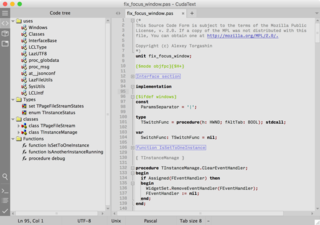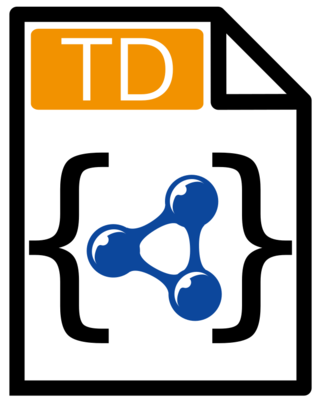Related Research Articles

A datasheet, data sheet, or spec sheet is a document that summarizes the performance and other characteristics of a product, machine, component, material, subsystem, or software in sufficient detail that allows a buyer to understand what the product is and a design engineer to understand the role of the component in the overall system. Typically, a datasheet is created by the manufacturer and begins with an introductory page describing the rest of the document, followed by listings of specific characteristics, with further information on the connectivity of the devices. In cases where there is relevant source code to include, it is usually attached near the end of the document or separated into another file. Datasheets are created, stored, and distributed via product information management or product data management systems.
Product data management (PDM) should not be confused with product information management (PIM). PDM is the name of a business function within product lifecycle management (PLM) that is denotes the management and publication of product data. In software engineering, this is known as version control. The goals of product data management include ensuring all stakeholders share a common understanding, that confusion during the execution of the processes is minimized, and that the highest standards of quality controls are maintained.
A product feed or product data feed is a file made up of a list of products and attributes of those products organized so that each product can be displayed, advertised or compared in a unique way. A product feed typically contains a product image, title, product identifier, marketing copy, and product attributes. But, can also contain links to rich media assets such as videos, 3D animations, brochures, product stories, product relations, and reviews, as in the case of Open Icecat, the multilingual open content catalogue.
Product information management (PIM) is the process of managing all the information required to market and sell products through distribution channels. This product data is created by an internal organization to support a multichannel marketing strategy. A central hub of product data can be used to distribute information to sales channels such as e-commerce websites, print catalogues, marketplaces such as Amazon and Google Shopping, social media platforms like Instagram and electronic data feeds to trading partners. Moreover, the significant role that PIM plays is reducing the abandonment rate by giving better product information.
Batavi is an open-source webshop under the GNU General Public License. The development of Batavi started in 2007 inspired by a preliminary osCommerce 3.0 version, a version that seemed to be never finished by the osCommerce team. In Batavi, an Object oriented design model is adopted, and on a functional level XML-EDI integration with the systems of suppliers is a lead theme, as most merchants don't run 'standalone' webshops. This distinguishes Batavi also from other webshops like PrestaShop, Zen Cart and Magento.
Entity–attribute–value model (EAV) is a data model to encode, in a space-efficient manner, entities where the number of attributes that can be used to describe them is potentially vast, but the number that will actually apply to a given entity is relatively modest. Such entities correspond to the mathematical notion of a sparse matrix.

In computing, linked data is structured data which is interlinked with other data so it becomes more useful through semantic queries. It builds upon standard Web technologies such as HTTP, RDF and URIs, but rather than using them to serve web pages only for human readers, it extends them to share information in a way that can be read automatically by computers. Part of the vision of linked data is for the Internet to become a global database.

Magento is an open-source e-commerce platform written in PHP. It uses multiple other PHP frameworks such as Laminas and Symfony. Magento source code is distributed under Open Software License (OSL) v3.0. Magento was acquired by Adobe Inc in May 2018 for $1.68 billion.
The following is a comparison of the features of notable shopping cart software packages available. Some such shopping cart software is extensible through third-party software components and applications. As such, the features listed below may not encompass all possible features for a given software package. The software listed here is but a fraction of all such packages on the market.
Open Catalog Interface (OCI) is a standard protocol developed by SAP for punch-out catalogs that connect buyers' procurement systems with suppliers' eCommerce systems. OCI is an alternative to cXML.
In computing, Open Data Protocol (OData) is an open protocol that allows the creation and consumption of queryable and interoperable REST APIs in a simple and standard way. Microsoft initiated OData in 2007. Versions 1.0, 2.0, and 3.0 are released under the Microsoft Open Specification Promise. Version 4.0 was standardized at OASIS, with a release in March 2014. In April 2015 OASIS submitted OData v4 and OData JSON Format v4 to ISO/IEC JTC 1 for approval as an international standard. In December 2016, ISO/IEC published OData 4.0 Core as ISO/IEC 20802-1:2016 and the OData JSON Format as ISO/IEC 20802-2:2016.
Pimcore is an open-source enterprise PHP software platform for product information management (PIM), master data management (MDM), customer data management (CDP), digital asset management (DAM), content management (CMS), and digital commerce.
List & Label is a professional reporting tool for software developers. It provides comprehensive design, print and export functions. The software component runs on Microsoft Windows and can be implemented in desktop, cloud and web applications. List & Label can be used to create user-defined dashboards, lists, invoices, forms and labels. It supports many development environments, frameworks and programming languages such as Microsoft Visual Studio, Embarcadero RAD Studio, .NET Framework, .NET Core, ASP.NET, C++, Delphi, Java, C Sharp and some more. List & Label either retrieves data from various sources via data binding, or works database independent. Reports are designed and created in the so-called List & Label Designer and then exported into a multitude of formats like PDF, Excel, XHTML and RTF. Since version 27 a web report designer for ASP.NET MVC is available.
Braintree is a Chicago-based company that primarily deals in mobile and web payment systems for e-commerce companies. The company was acquired by PayPal on September 26, 2013.

Apache Drill is an open-source software framework that supports data-intensive distributed applications for interactive analysis of large-scale datasets. Built chiefly by contributions from developers from MapR, Drill is inspired by Google's Dremel system, also productized as BigQuery. Drill is an Apache top-level project. Tom Shiran is the founder of the Apache Drill Project. It was designated an Apache Software Foundation top-level project in December 2016.
Grunt is a JavaScript task runner, a tool used to automatically perform frequent tasks such as minification, compilation, unit testing, and linting. It uses a command-line interface to run custom tasks defined in a file. Grunt was created by Ben Alman and is written in Node.js. It is distributed via npm. As of October 2022, there were more than 6,000 plugins available in the Grunt ecosystem.
Sendinblue is a SaaS solution for relationship marketing. The company was founded in 2007 by Armand Thiberge and Kapil Sharma, and offers a cloud-based marketing communication software suite with email marketing, transactional email, marketing automation, customer-relationship management, landing pages, Facebook ads, retargeting ads, SMS marketing, and more.

CudaText, from Bosnian-Croatian-Montenegrin-Serbian čuda, is a free open source cross-platform native GUI text and source code editor. CudaText supersedes its predecessor SynWrite, no longer under development.

The Thing Description (TD) is a royalty-free, open information model with a JSON based representation format for the Internet of Things (IoT). A TD provides a unified way to describe the capabilities of an IoT device or service with its offered data model and functions, protocol usage, and further metadata. Using Thing Descriptions help reduce the complexity of integrating IoT devices and their capabilities into IoT applications.
References
- ↑ "Manual: Download Individual Product XML". Iceclog.com. Icecat. Retrieved 3 September 2019.
- ↑ "Manual for Open Icecat JSON requests". Iceclog. Icecat. Retrieved 3 September 2019.
- ↑ "Manual for CSV Interface". Iceclog. Icecat. Retrieved 3 September 2019.
- ↑ "osCommerce Community Add-Ons". Oscommerce.com. Retrieved 2013-06-24.
- ↑ "Icecat Integrations with Magento, PrestaShop, WooCommerce, OpenCart, Zen Cart".
- ↑ Archived November 9, 2009, at the Wayback Machine
- ↑ "Wicecat". Wasato.net. Retrieved 2013-06-24.
- ↑ "Icecat Node.js API". GreenCore.
- ↑ "Icecat Add-ons". Iceclog.com.